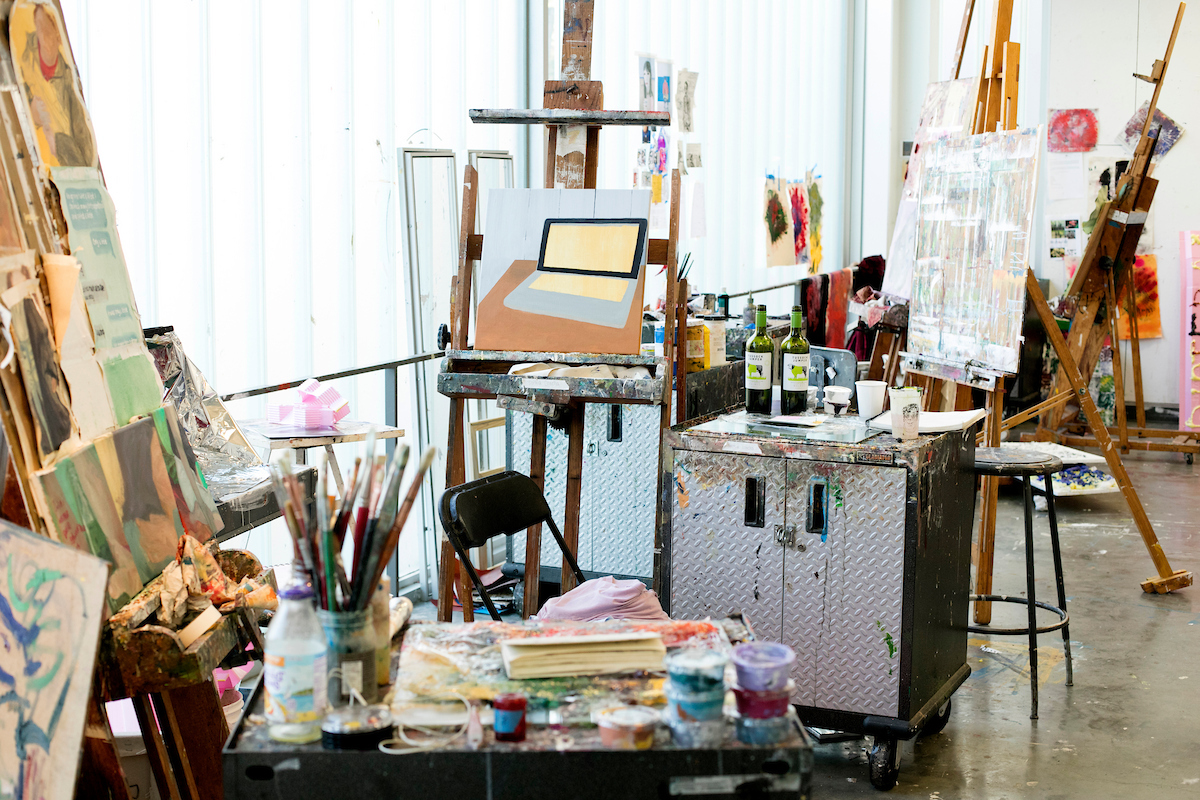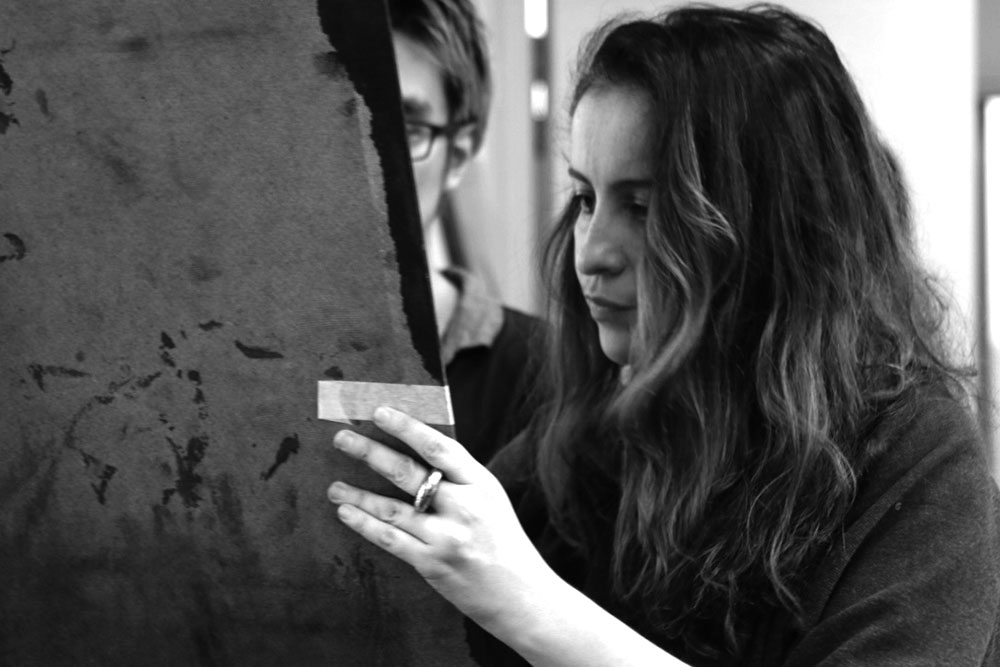
The three-week precollege visual arts program From Drawing to Painting to Experimentation is one of the top summer programs for high school students who are serious about art.
Basic Elements of the Precollege Visual Arts Curriculum
In the From Drawing to Painting to Experimentation precollege program, which runs from Monday through Friday for three weeks, students spend five hours each day with Sarah Lawrence faculty learning, experimenting, and honing skills while producing original work. The program is rooted in Sarah Lawrence College's exceptional visual arts program.
In addition to five hours with instructors, each day also includes a two-hour session for individual work with a teaching assistant. This is an opportunity to receive supplementary mentorship. Teaching assistants work with students on an individual basis, providing critique and personalized instruction and assist in further developing portfolio-level works.
Works generated in the program are ideal for inclusion in a portfolio that can accompany college applications.
Students who successfully complete the Precollege Visual Arts Program will receive an official transcript with three college credits that can be used at Sarah Lawrence College or transferred to most other colleges and universities.
Daily Schedule
9 a.m. – 12 p.m.
Studio with faculty
12 – 1 p.m.
Lunch (included in tuition)
1 – 3 p.m.
Studio with faculty and teaching assistant mentor
3 – 3:30 p.m.
Break
3:30 – 5:30 p.m.
Studio work with teaching assistant mentor
Detailed Curriculum
This project-based studio course leads students from the fundamentals of observational drawing into painting and mixed-media experimentation, helping them build essential technical skills while beginning to develop a personal visual language. Through guided prompts, demonstrations, and hands-on practice, students explore core visual elements, learn to communicate ideas clearly, and move from traditional techniques into more inventive materials and approaches. In addition to daily studio time with the faculty instructor, students receive two hours of individual studio time each day with a Teaching Assistant mentor, who offers personalized guidance and feedback as students' work evolves. By the end of the program, students will have produced a substantial body of drawings and paintings, numerous portfolio-ready, and will have gained the confidence to experiment, revise, and think visually with intention. All materials are included in the tuition price.
Course Description
Students receive specific prompts that guide them to generate work that is uniquely their own. Some prompts focus on observational drawing and painting, while others are more abstract. Technical exploration, perception, idea development, intuition, invention, representation, and communication form the core of the class.
Students use drawing elements such as line, volume, shape, negative space, scale, weight, light and shadow, contrast, composition, rhythm, movement, and texture to communicate their concepts. They slowly transition from drawing to painting and learn about different tools, mixing color, and various painting languages. Painting begins with observational practice and then shifts toward expressing more personal ideas. In addition to paint, students explore less traditional materials such as paper collage, fabric collage, and paper mâché. Learning happens through practice and failure.
The studio functions as a lab where ideas are worked out and meaning is made. Students are encouraged to avoid relying solely on skills and experiences they already possess. Instead, they are encouraged throughout the course to remain curious, allowing themselves to venture into unexpected places, and challenging themselves toward openness and progress. The process involves critical thinking, intuition, and substantial physical labor.
What Will Students Do?
- Students will develop observational and technical skills. The class begins with drawing, as drawing is at the foundation of visual thinking. It is a necessary skill for communicating what the artist sees and for expressing ideas. All other skills build upon this one. The class starts with observational drawing and moves into idea-based drawing. Drawing also serves as a tool for planning other types of work — as a tool of investigation, expansion, and exploration of possibilities.
- Students will learn about composition and design, exploring methods for organizing visual information into dynamic and inventive arrangements. Being intentional about the use of formal elements of design (balance, shape, color, pattern, and space) strengthens communication and allows expression to become clearer and more direct.
- Students will learn visual research, including how to search for visual information that strengthens, supports, and communicates an idea. They will explore where artists find visual references and how these are used toward artistic goals. Revision is a natural and essential part of the class — the ability to return to a piece and adjust, change, rethink, and transform it.
- Students will create a series of paintings. Students begin with observational work and end with more idea-based or abstract approaches. This progression defines the arc of the class.
- Students will work with traditional and non-traditional materials. Painting begins on more traditional surfaces with traditional materials and ends with more experimental and alternative materials.
What Will Students Produce?
- Students will produce a body of work throughout the course. They will learn new skills while leaving the experience with several portfolio-level completed pieces.
- Class studio hours and homework hours will be devoted to completing at least six exercises and six finished pieces (drawings, paintings, sculptural paintings; two exercises and two finished pieces per week).
Student Learning Outcomes
Students will:
- Learn the fundamentals of drawing
- Grasp the formal elements of design — color, line, shape, value, texture, composition, repetition, contrast, rhythm, focal point, perspective — and understand how to use these elements to communicate visual ideas more clearly
- Gain familiarity with the tools of painting, mixing paint, stretching canvases, and preparing a variety of traditional and nontraditional supports and surfaces
- Sharpen their ability to do artistic research and develop concepts for paintings
- Become familiar with the historic tradition of painting as well as contemporary painting through visual lectures
- Learn about different techniques and languages of painting
- Build confidence in working with complex visual challenges and varied subject matter, including still life, landscape, architectural and organic shapes, text, and the body
- Learn how to give productive critique to others and to themselves, an essential step toward independent studio practice
- Learn how to participate in an artistic community in a productive, generous, and joyful way
- Take first steps toward developing a personal visual language and forming specific interests and ideas in relation to painting
- Learn about many options for material experimentation, using traditional and nontraditional painting materials to expand the definition of painting and explore new possibilities
- Begin speaking the language of painting
- Produce six exercises and six finished pieces (two of each per week)
- Begin thinking about building a portfolio and what that process entails (high completion level, variety of work, curation, photography, labeling, arranging work in a meaningful order, etc.)
Number of Hours
75 hours over three weeks
Five days per week, five hours per day
Additionally, students receive two hours per day (30 hours total) of individual studio time with a Teaching Assistant mentor who provides mentorship and feedback.
Meet the Faculty
 Yevgeniya Baras is an artist working in New York. She has exhibited her work at the Brooklyn Museum, White Columns, NY; The Landing, LA; Reyes Finn Gallery, Detroit; Gavin Brown Enterprise, NY; Nicelle Beauchene, NY; Mother Gallery, NY; Inman Gallery, Houston; Sperone Westwater Gallery, NY; Thomas Erben Gallery, NY; the Pit, LA; Soco, NC as well as internationally including NBB Gallery, Berlin; Julien Cadet Gallery, Paris; Station Gallery, Sydney. She is represented by Sargent’s Daughters in NY.
Yevgeniya Baras is an artist working in New York. She has exhibited her work at the Brooklyn Museum, White Columns, NY; The Landing, LA; Reyes Finn Gallery, Detroit; Gavin Brown Enterprise, NY; Nicelle Beauchene, NY; Mother Gallery, NY; Inman Gallery, Houston; Sperone Westwater Gallery, NY; Thomas Erben Gallery, NY; the Pit, LA; Soco, NC as well as internationally including NBB Gallery, Berlin; Julien Cadet Gallery, Paris; Station Gallery, Sydney. She is represented by Sargent’s Daughters in NY.
 Yevgeniya is a recipient of the Pollock-Krasner grant in 2023 and 2018. She was named Senior Fulbright Scholar for 2022/2023 and was a recipient of the New York Foundation for the Arts Fellowship in 2021 and a Guggenheim Fellowship in 2019. Yevgeniya was selected for the Chinati Foundation Residency in 2018 and the Yaddo Residency in 2017. She received the Artadia Prize and was selected for the Sharpe-Walentas Studio Program and the MacDowell Colony residency in 2015. In 2014 she was named a recipient of the Rema Hort Mann Foundation’s Emerging Artist Prize. Her work has been reviewed in The New York Times, Los Angeles Times, ArtForum, The New York Review of Books, and Art in America.
Yevgeniya is a recipient of the Pollock-Krasner grant in 2023 and 2018. She was named Senior Fulbright Scholar for 2022/2023 and was a recipient of the New York Foundation for the Arts Fellowship in 2021 and a Guggenheim Fellowship in 2019. Yevgeniya was selected for the Chinati Foundation Residency in 2018 and the Yaddo Residency in 2017. She received the Artadia Prize and was selected for the Sharpe-Walentas Studio Program and the MacDowell Colony residency in 2015. In 2014 she was named a recipient of the Rema Hort Mann Foundation’s Emerging Artist Prize. Her work has been reviewed in The New York Times, Los Angeles Times, ArtForum, The New York Review of Books, and Art in America.
Yevgeniya co-founded and co-curated Regina Rex Gallery on the Lower East Side of NY (2010-2018). She holds a BA in Psychology and Fine Arts and an MS in Education from the University of Pennsylvania and an MFA in Painting and Drawing from the School of the Art Institute of Chicago. Yevgeniya has taught art at universities since 2007 and at Sarah Lawrence College since 2018.